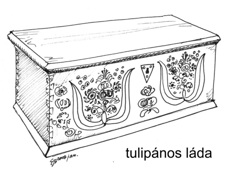The Hungarian riven chests is the oldest storage-furniture in the area. This type of furniture was found in the ancient Greek culture,
there is an imagery of it in a French cathedral also. The oldest terracotta chest-form is 4000 years old (in Crete). The knowledge
of creating this ancient furniture was lost over time, only the Hungarian (and Transylvanian) craftmen preserved it, only in the folk culture.
Gyenes Tamás, acsoltlada.hu
In Hungary there are two main types of dowry chests: the riven chest and the painted chest – they are significantly different.
The riven chest is a thousands of years old type with four column-legs, in which the side-planks slip in. The substance of this
ancient techique is: the unseasoned beech trunk is riven along its length by driving an axe , then a groove is made along the edges
of each plank to join the planks together – to join the walls of the chest. The maker of the riven chest uses axes, hand-saw,
and simply shaves the planks with a drawknife on the shaving horse.
The other type called a „painted chest” or „joiner’s chest” is completetely different. The planks are made with sawmills and
the joiners must use very seasoned timber to make a chest. The master’s main tool is not the drawknife, but the plane.
The (Hungarian) joiner’s chest has no legs, the sides of the chest are jointed with „dovetail” technique, and sticked with glue (gelatin).
Joint furniture was hand-painted, often ornamented with flower-patterns, with tulip, this is the reason why it is often called
it „tulipános láda” (chest with tulip). In the Hungarian folk culture the joiner”s chest spread widely only in XVIII-XIX. century.
The riven chest was still use as dowry chest in the first half of XX. century by the Hungarian village people.
Later the two-door cabinet took over the original function and name („szekrény”) of the riven chest.
This medieval craft is preserved in practice in Hungary, in the Carpathian Basin only.
Stork Istvan was the last riven-chest master in 1950’s. The ethnografers K. Csillery Klára and Keszi-Kovács László filmed him as he was working.
The master, who lived in Matraalmas, made not the original type of the classical Hungarian riven chests,
he made a renewed version (type Matraalmas, as I call). For example the chest Matraalmas was decorated
with recurrent patterns only, without any meaning. The original old chests have reasoned composition, with beautiful meaning.
I follow this ancient tradition – I follow the old palóc masters work.

Gyenes Tamás's riven wood chests and folk-flutes



